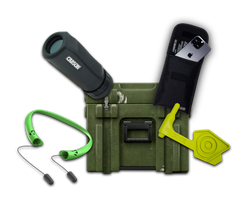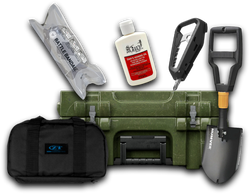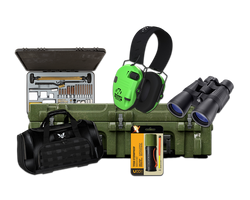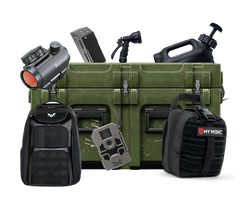What Color Headlamp for Deer Hunting: A Comprehensive Guide
Table of Contents
- Introduction
- The Science of Deer Vision
- Choosing the Right Headlamp Color
- Practical Considerations for Headlamp Selection
- Best Practices for Using Headlamps in the Field
- Making the Most of Your Headlamp: Integrate with Crate Club Gear
- Conclusion
- FAQ
Introduction
Imagine you're in the serene woods at dawn, the crisp air fills your lungs as you prepare for a day of deer hunting. You’ve gathered your gear, checked your rifle, and now you're contemplating a key component: your headlamp. Did you know that the color of your headlamp can significantly impact your success in the field? Research indicates that deer have unique vision adaptations, which means that the wrong color light could spook your quarry.
This blog post dives deep into the nuances of choosing the right headlamp color for deer hunting, discussing the science behind deer vision, the pros and cons of various light colors, and practical considerations for selecting your gear. By the end of this article, you’ll have a comprehensive understanding of what color headlamp is optimal for your hunting needs and how to use it effectively in the field.
The Science of Deer Vision
Understanding how deer see is crucial for selecting the appropriate headlamp color. Deer possess a unique structure in their eyes called the tapetum lucidum, which enhances their night vision. This reflective layer allows them to utilize low-light conditions better than humans. However, their color perception differs significantly from ours.
Color Sensitivity
Research shows that deer are dichromatic, meaning they primarily see two colors. They can perceive blue and green wavelengths more effectively and have limited sensitivity to red wavelengths. This characteristic makes them less responsive to red light, which can be advantageous for hunters.
- Blue Light: Highly visible to deer, which can be a disadvantage while hunting.
- Green Light: Less alarming to deer, as they perceive it in shades of gray rather than bright colors.
- Red Light: The least visible to deer, making it a popular choice among hunters.
Implications for Headlamp Usage
Given these adaptations, utilizing colored headlamps can enhance your stealth during deer hunting. The strategic use of red and green lights allows hunters to maintain visibility while minimizing the chances of spooking deer.
Choosing the Right Headlamp Color
When it comes to selecting a headlamp for deer hunting, the primary colors to consider are red, green, and white. Each color has its distinct advantages and disadvantages.
Red Headlamps
Pros:
- Reduced Spook Factor: Deer are less able to detect red light, making it less likely that they will be startled.
- Night Vision Preservation: Red light helps maintain your night vision, allowing you to adjust to the dark without the blinding effects of white light.
- Good for Navigation: Red light provides sufficient illumination for moving around without compromising stealth.
Cons:
- Limited Brightness: Red light may not illuminate as brightly as white or green, which could be a concern in dense environments.
- Not Ideal for Tracking: If tracking blood trails, red light can make it difficult to see the color contrast of blood.
Green Headlamps
Pros:
- Enhanced Visibility: Green light is brighter than red and can illuminate a wider area, making it easier to navigate through the woods.
- Deer-Friendly: Like red light, green is less likely to alarm deer, though they can still see it.
- Good for Blood Tracking: Green light provides better visibility for tracking blood trails compared to red.
Cons:
- Potential for Spooking: Some hunters report that deer can still see green light, especially if they are already alert.
- Night Vision Compromise: Bright green light can affect your night vision if used extensively.
White Headlamps
Pros:
- Maximum Brightness: White light provides the best illumination for visibility, making it easier to navigate and spot obstacles.
- Ideal for Tracking: White light is excellent for tracking blood trails due to its brightness.
Cons:
- High Spook Factor: White light is the most startling to deer, which can cause them to flee if they are within range.
- Night Vision Disruption: Using white light can significantly impair your night vision, making it harder to see after the light is turned off.
Practical Considerations for Headlamp Selection
Beyond color, several factors should influence your choice of headlamp for deer hunting.
Brightness and Beam Distance
The brightness of a headlamp is measured in lumens. For hunting, a headlamp with adjustable brightness settings is ideal. It allows you to use a lower setting while navigating to the stand and switch to a higher setting for better visibility when needed.
Battery Life
Ensure your headlamp has a long battery life or is rechargeable. A headlamp that quickly drains can leave you in the dark at critical moments. Consider carrying spare batteries or a portable charger if you choose a rechargeable option.
Comfort and Fit
Your headlamp should fit securely and comfortably on your head. Look for adjustable straps and lightweight materials to avoid discomfort during long hours in the field.
Durability and Weather Resistance
Hunting often involves rugged terrain and unpredictable weather. Choose a headlamp that is water-resistant and built to withstand rough conditions.
Additional Features
Some headlamps come with features such as:
- Multiple Modes: Flashing modes for signaling others.
- Red/Green Filters: These can be added to a white light headlamp for versatility.
- Weight: Lightweight models are less cumbersome for long hunts.
Best Practices for Using Headlamps in the Field
- Use the Right Color: Switch to red or green light as you approach your stand to minimize the risk of spooking deer.
- Stay Low: When using your headlamp, keep the beam directed downwards to avoid illuminating the surrounding area excessively.
- Be Aware of Your Noise Levels: While your light can help you navigate, it’s your movement that often alerts deer. Be as quiet as possible.
- Limit Light Exposure: Turn off your headlamp when you are settled in your tree stand or blind to reduce the chances of drawing attention.
- Practice: Familiarize yourself with your headlamp before the hunt. Practice switching between modes and adjusting the beam to maximize your efficiency.
Making the Most of Your Headlamp: Integrate with Crate Club Gear
At Crate Club, we understand the importance of high-quality tactical gear, including headlamps suited for various situations, including deer hunting. Our subscription services offer curated tactical gear that can enhance your hunting experience.
Explore our Crate Club Subscription Services, where you can choose from different tiers, tailored to meet your specific needs and experience level. Whether you’re a novice or a seasoned hunter, our curated selections can elevate your gear game.
Additionally, check out the Crate Club Shop for specific headlamp options and other essential tactical gear that will aid you in your hunting endeavors.
Conclusion
Selecting the right color headlamp for deer hunting is not just a matter of preference; it’s a strategic choice that can influence your success in the field. Red and green headlamps offer distinct advantages over white light, aligning with the unique vision capabilities of deer.
By considering factors such as brightness, battery life, and comfort, you can ensure that your headlamp serves you well during your hunting adventures. Armed with this knowledge, you can navigate the wilderness more effectively while minimizing the chances of spooking deer.
Engage with your fellow hunters and share your experiences. What color headlamp do you prefer for deer hunting? Your insights could help fellow enthusiasts enhance their hunting strategies.
FAQ
What color headlamp is best for deer hunting?
Red and green headlamps are generally considered the best options for deer hunting as they are less likely to spook deer compared to white light.
Can deer see red light?
Deer have limited ability to see red light, making it a good choice for hunters looking to minimize disturbance.
Is it necessary to use a headlamp?
While not strictly necessary, a headlamp is incredibly beneficial for navigating in low-light conditions and performing tasks hands-free.
How bright should a headlamp be for deer hunting?
A headlamp with at least 200 lumens is recommended, but adjustable brightness settings can offer flexibility based on your needs.
Should I carry extra batteries?
Yes, it’s always a good idea to carry spare batteries to ensure your headlamp remains operational throughout your hunting trip.
By understanding the nuances of headlamp colors and their effects on deer, you can enhance your hunting experience and increase your chances for success in the field.
Share this article



